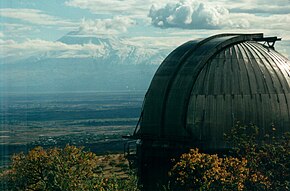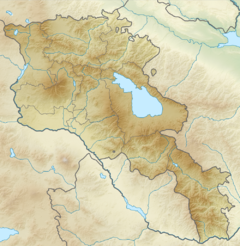Byurakan Observatory
 | |||||||
| Alternative names | Byurakan Astrophysical Observatory | ||||||
|---|---|---|---|---|---|---|---|
| Named after | Viktor Ambartsumian | ||||||
| Organization | Armenian Academy of Sciences | ||||||
| Observatory code | 123 | ||||||
| Location | Mount Aragats, Armenia | ||||||
| Coordinates | 40°19′51″N 44°16′06″E / 40.33083°N 44.26833°E | ||||||
| Altitude | 1,400 m (5,000 ft) | ||||||
| Established | 1946 | ||||||
| Website | www | ||||||
| Telescopes | |||||||
| |||||||
| | |||||||
The Byurakan Astrophysical Observatory, or Byurakan Observatory is an astronomical observatory owned and operated by the Armenian Academy of Sciences. It is located on the slope of Mount Aragats in the village of Byurakan in Armenia.
History
Founded in 1946 by Viktor Hambardzumyan, it was one of the main astronomy centers of the USSR. The buildings were designed by architect Samvel Safarian. The hotel, central building and structures for astronomical instruments.[1] The observatory has discovered special star clusters - stellar associations (1947),[1] more than 1,000 flare stars, dozens of Supernovae, hundreds of Herbig-Haro objects and cometary nebulae, hundreds of galaxies. After the breakup of the Soviet Union, the observatory fell into hard times.
The fist conference was held in November 1951 on the topic of stellar associations. In 19 September 1956 a major meeting on non-stable stars was held.[1] It has been the site of two major conferences on SETI, and is recognised as the regional center for astronomical research.[1]
Directors included V.A. Ambartsumian till 1988, E.Ye. Khachikian till 1993, H.A. Harutyunian from 1993 to 1994, and A.R. Petrosian from 1994-1999. Khachikian returned as director from 1999-2003 and Harutyunian also returned after this.[1]
Equipment
Byurakan Observatory's main telescope is a 2.6 m cassegrain reflector, along with a 1 and .5 m Schmidt camera as well as other smaller telescopes.
Results
The First Byurakan Survey commenced in 1965 using the Schmidt telescope. It revealed 1500 galaxies with ultraviolet excess known as the Markarian galaxies.[1] These galaxies are designated "Markarian" or "Mrk" followed by a number, for example Mrk 501.
The Second Byurakan Survey started in 1978 looking for quasars, emission line galaxies and ultraviolet excess galaxies.[1]
Gallery
-
More telescopes at the Observatory


